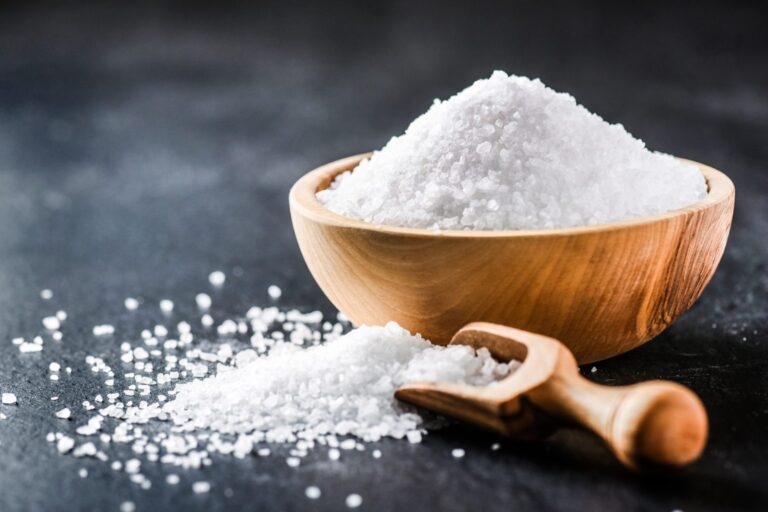The salt we consume is sodium chloride (NaCl). It is an essential ingredient in
cooking that can be classified according to its composition and processing
(standard, refined, and marine) and grain characteristics (coarse, sifted, crushed, and
ground).
Its primary technical functions, among others, are:
- Flavor enhancement: salt enhances the perception of sweet, acid, and bitter
tastes.
- Preservative: salt creates an environment that inhibits the growth of some
pathogenic microorganisms and prevents food spoilage.
- Texturizer: salt helps to fortify gluten in pasta, provides tenderness to meat,
and develops essential cheese characteristics, such as hardness.
In addition, sodium chloride also plays essential roles in the human body, such as
nerve impulse transmission, muscle contraction and relaxation, water and mineral
balance, and blood pressure regulation.
However, excessive salt intake may cause severe body disorders, including heart
and bone conditions, kidney damage, swelling, and blood hypertension.
In short, limiting salt intake is essential, and salt content should be carefully
considered when preparing foods or buying processed food products. Drinking more
water and eating fresh, natural foods are critical to a healthier diet.
CONSUMERS’ RELATIONSHIP WITH SODIUM
Consumers are increasingly aware of the need to reduce their salt intake for their
overall health and well-being. Although it is impossible to change some factors, such
as genetics and family history, dietary sodium intake can be reduced, resulting in better
blood pressure control and lower hypertension risk.
According to the Dietary Guidelines for Americans (2020-2025), the number of North
American adults who exceed the sodium Chronic Disease Risk Reduction Intake
during this stage of life is concerning: 45% of people in the US aged 18 and over live
with hypertension.
Consumers around the world are already looking for low-sodium food and beverage
options:
- 36% of Northern Irish consumers are concerned with the salt content of their
diets. 1
- 45% of Chinese consumers are aware of the importance of maintaining a light
diet (less oil/salt/sugar) and made it a habit. 1
- 61% of Brazilians say that they would not, under any circumstances, buy
sodium-rich foods. 1
Excessive sodium intake occurs for several reasons, as sodium is present in foods
and beverages across all food groups.
One action that informs consumers of the sodium content of foods is front-of-pack
labels. In many countries, front-of-pack labeling is a legal requirement, ensuring
that food products comply with labeling regulations established to protect public health.
To learn more about the importance of front-of-pack labels, read our article.
Reducing sodium intake is not an individual task but a collective effort. It is a
responsibility shared by consumers, the food and beverage industries, and food service
establishments.
WHO RECOMMENDATIONS
The World Health Organization (WHO) recommends that adults reduce their salt
intake to less than 5 grams daily (about one teaspoon) to aid in lowering blood
pressure and reducing health risks. It also states that this change could save around 2
million lives annually.
What are the advantages of reducing the sodium content for the food industry?
According to the WHO, for every US$1 invested in scaling up sodium reduction
interventions, there is a return of at least US$12.
However, the challenge for companies is to reduce sodium without
compromising the flavor of their products, a key factor for purchase decisions. A
solution is to include natural ingredients to enhance their products’ flavor.
YEAST EXTRACTS AS AN ALTERNATIVE FOR SODIUM REDUCTION
Yeast extract is an example of a natural ingredient that enriches and rounds off the
flavor of formulations, intensifying the perception of juiciness to compensate for salt reduction.
Biorigin, committed to promoting people’s health and well-being, has developed,
throughout its history, several yeast extract solutions that compensate for sodium
reduction.
Bionis is Biorigin’s versatile line of yeast extracts that adds and enhances the
flavor of formulations, providing body and mouthfeel and balancing and rounding off the
natural Umami flavor of several food and beverage applications. They also enhance
the salty taste in sodium-reduced applications.
To demonstrate in practice the applicability of our Bionis line for sodium-reduced
recipes, we created a recipe book with the following formulations:

Create delicious and successful recipes with reduced sodium! To see our delightful
yeast extract recipes, click here.
For more than 20 years, Biorigin has applied its knowledge and experience in
biotechnology to make the best of the yeast fermentation process and develop,
together with its partners, the best flavor solutions for healthy and convenient
foods cleanly and sustainably.
Sources:
¹ Mintel – Patent insights: innovation in salt reduction (2021)
² Mintel – Patent insights: cardiovascular health (2021)








